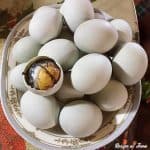Balut Fertilized Duck Eggs Recipe
Balut is believed to be a potent aphrodisiac and cure for hangovers. Others eat it as a standalone meal due to its high level of nutrients. It's a nutritious snack, high in protein and calcium.
Servings 4 people
Cost $3
Ingredients
- 8 thick-shelled eggs
- 1 cup palay rice (unhusked rice)
Instructions
- Select duck or chicken eggs by tapping the eggs with your fingers to pull out cracked or thin-shelled eggs. Eggs with cracks have a hollow sound while thin-shelled ones have a brittle sound.
- Only thick-shelled eggs are used for balut making because these can withstand the stresses of egg placement and removal in cylindrical baskets called “toong”. These are open on both ends, 34 inches high and 21 inches in diameter; spaces around are filled with rice hulls up to 4 inches from the brim. Ideally, eggs made into balut shouldn't be older than 5 days from the time they're laid.
- Roast or heat palay to a temperature of 107 °F or 430 °C in an iron vat or cauldron. Remove palay when you can hold it in your hands.
- Eggs are then placed in the toong; these are alternated with heated palay bags. The number of heated palay bags is 1 for every egg bag. Placed 2 heated palay bags on the bottom and 2 on the top level to ensure heat conservation. For every toong containing 10 layers of eggs, you'll need 13 bags of roasted palay.
- Each toong can hold 10 bags. Cover with just sacks to conserve heat further. Candling is the process of holding eggs against the hole of a lighted box in a dark room to separate infertile eggs from fertile ones. Infertile eggs are called penoy; these are also boiled like balut but fetch a lower price.
- First, candling is done on the 11th day after eggs are placed in toong. Candling is done again on the 17th day to separate eggs with dead embryos (abnoy) and those that are ready to be sold as balut. Eggs with weak embryos take 18-20 days to be released; these are hard boiled and sold.
- Eggs intended for hatching are left in the balutan for 28 days when ducklings will hatch. After 20 days, palay bags aren't heated anymore since embryos can generate enough heat to keep themselves warm.
- When using kerosene or electric incubators for hatching duck eggs, maintain a temperature of 100°F and humidity from 55% to 60%. Don't hatch duck and chicken eggs together in 1 incubator, as duck eggs require a different temperature and a higher rate of humidity. A pan of water kept in the bottom of the incubator helps maintain humidity level. During the incubation period, turn eggs at least 3 to 4 times a day to raise your chances of hatchlings.
- Clean hatching eggs with a slightly moist and clean rag before storing to prevent contamination of the developing embryo or newly hatched chicks.
